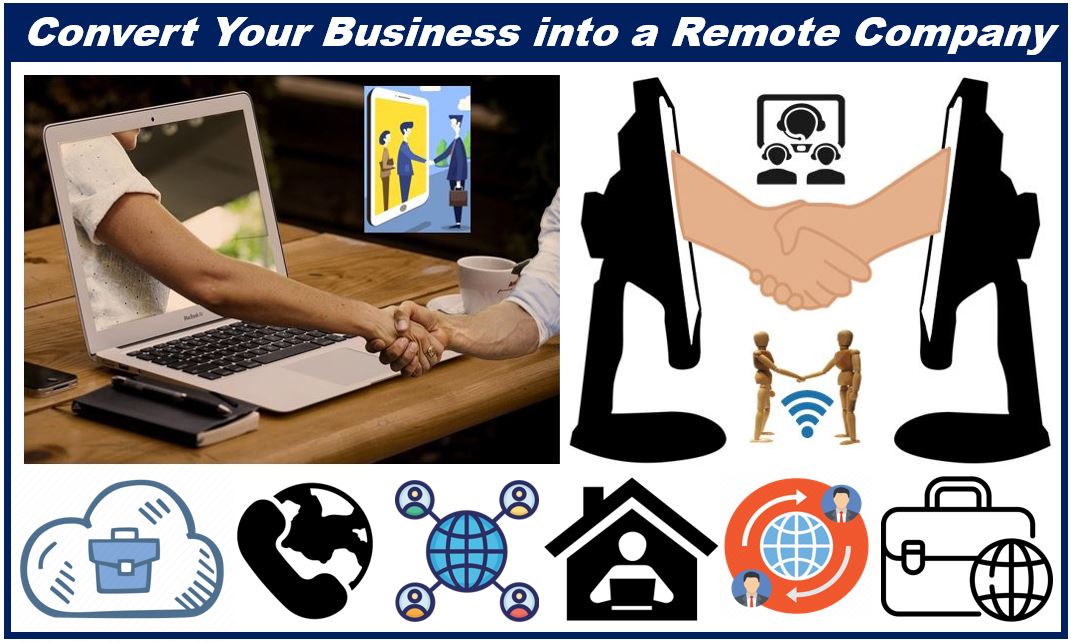Are you interested in converting your existing business into a remote company? Whether you’re ditching brick and mortar altogether or just adding a remote function to your firm, these five tips will help you manage a smooth transition.

1. Be prepared to start from scratch
Your first consideration should be whether or not you can turn your existing business into a remote operation. Some businesses are easy, but some won’t work remotely. If you own a nail salon, for instance, there’s really no way you can offer your services remotely.
If your existing company won’t perform remotely, you’ll have to start from scratch and create a brand-new business. This can be exciting, especially if you’ve wanted to start a new project for a while.
If you’re stuck for ideas, Under30CEO published an article that discusses fifteen different remote business opportunities. Some of their ideas require technical skills, such as being able to perform the work of an app developer or video editor, but others are mainstream, like making custom greeting cards or being a career coach.
You’ll have an easier time going with a business that doesn’t require keeping inventory on hand and mailing packages. But if you’re passionately interested in selling a particular product, it’s worth the work.
2. Expand your product line and/or services
Sometimes the only way to turn a business into a successful remote company is to increase the selection of products and/or services you offer. Amazon started out selling only books, but has expanded to become the largest online retailer in the world: You can find just about anything on Amazon today.
If you have a niche market and want to stay specialized, you could be successful that way. It primarily depends on your market and your willingness to promote your business.
If you’re already well-known and have a great reputation, you probably won’t have an issue with going remote.
3. Reduce your products and services
Although expanding products and services can boost some remote businesses, reducing one’s array of products and services might also be the key. Say you run a restaurant that offers 140 dishes on the menu and you’d like to start delivering with online orders.
Does your restaurant have enough space to cook all of your menu items for dine-in and delivery? Do you have enough cooks? Does it take special skills to make some of your dishes, or can you hire anyone to whip up your offerings?
Unless all your dishes are quick and easy, you’re most apt to achieve greater success by reducing the menu items you deliver. You can generate more business by establishing a special satellite location that sells a small percentage of your usual menu. You may even want to create new, more convenient menu items just for delivery.
When you run a remote business, the answer is to streamline everything as much as possible. You’ll need to eliminate products and services that complicate your online ordering functions.
4. Focus on communication and task management
Communication is critical whether you’re a solopreneur or if you plan to hire employees when the time is right.
To support communication within your business, find a cloud-based platform where everyone you work with can collaborate online. This includes you, your clients, contractors, remote employees, and in-house workers.
Take several task management programs for a test drive and see which one works best for you and your team. Here are several applications to try:
- Producteev. This is a good free task management application if you don’t need anything fancy.
- Asana. The simplicity of Asana’s interface is deceptive. It’s simple and easy, but incredibly powerful.
- Slack. Slack is by far the most popular of all workforce tools on the market. It’s perfect for tech companies, since conversations are siloed in categorized channels for better organization.
- Google Workspace. This is the best free online collaboration suite you’ll find. Almost everyone has a Google account, and if they don’t, it’s easy to create one.
- Microsoft 365. Microsoft 365 has all the tools Google Workspace has, but you need a subscription to use the programs.
- Monday. For more intensive needs, Monday offers a fantastic task management application for small and large teams.
5. Get a cloud-based storage account
Finally, you’ll need a cloud-based storage account to hold your company’s digital files. When selecting a platform, make sure you’ll have full control over who can get access to every file and folder.
Most people prefer Box because you can share files with a link that expires after a limited period of time, and you can prevent files from getting downloaded.
Be patient and never give up
Creating a new business can be an intimidating task, but it’s normal to feel that way about it. Nothing good is ever created without a little sweat. Be patient, stay the course, and you should be able to see your vision through to the end.
Interesting related article: “What is Teleworking?“
